Experimental Investigation of Adhesion Failure between Waterproof Coatings and Terrace Tiles under Usage Loads
Abstract
1. Introduction
2. Materials and Methods
2.1. Materials
- test substrate, i.e., concrete substrate [16], with dimensions 50 × 250 × 550 mm, made of Portland cement CEM I 42,5R, sand-gravel mix with grain size from 0 mm, ratio of binder to aggregate in the mixture 1:5 (by mass), W/C 0.5 to 8 mm, with a roughness indicator of about 0.46 mm and humidity about 2%,
- waterproof coating, applied as below, made of liquid-applied waterproofing product. The product sets were marked from 1 to 8 for the purpose of the test, and their characteristics are presented in Table 1,
- nine ceramic tiles of V1 type [18], with water absorption ≤0.5% by mass, unglazed, with plain adhering surface with facial dimensions of (50 ± 1) mm × (50 ± 1) mm.
- CM—cementitious liquid-applied water-impermeable products (so called cementitious thin-layer waterproofing mortars). These polymer-cement mortars include: cement, selected mineral aggregate with a grain size selected according to a specially developed screening curve, fibres and specific additives (specially modified resins, hydrophobic compounds etc.). This composition guarantees an effective waterproofing effect, even with small layer thicknesses. Added to this is a water polymer dispersion (or redispersible copolymers) that provides significant flexibility of the mortar after drying. An additional advantage of cement mortars is their ability to be applied on wet substrates. These mortars bind by hydration and drying.
- DM—liquid-applied water-impermeable products. They are solvent-free, consisting of the water dispersion of polymers. They guarantee full moisture protection and surface covers, even at layer thicknesses of 1.0 mm. They are characterised by good adhesion to various substrates and considerable flexibility. They dry by evaporating water.
- RM—reaction resin liquid-applied water-impermeable products. These are one- or two-component, solvent-free resins, consisting of synthetic resin components (usually based on polyurethanes), with the addition of fillers, pigments and modifiers. They provide substrate protection and watertightness when exposed to moisture and water in the presence of aggressive media. They are characterised by flexibility and very good adhesion to the substrate.
- set no 4: two reaction resin liquid components, no primer before application, total thickness of dried membrane was 2.0 mm,
- set no 6: two components: the first was a liquid emulsion and the second a cementitious powdery mortar, no primer before application only wetting the substrate with water, total thickness of dried membrane was 0.8 mm.
- set no1: dispersion liquid component ready for use after thorough mixing, substrate primed with the same chemical base, total thickness of dried membrane was 2.5 mm,
- set no 2: reaction resins liquid component ready for use after thorough mixing, no primer before application, total thickness of dried membrane was 1.5 mm,
- set no 3: reaction resins liquid component ready for use after thorough mixing, no primer before application, total thickness of dried membrane was 1.5 mm,
- set no 5: dispersion liquid component ready for use after thorough mixing, substrate primed with the same chemical base, total thickness of dried membrane was 2.0 mm,
- set no 7: dispersion liquid component ready for use after thorough mixing, substrate primed with the same chemical base, total thickness of dried membrane was 1.0 mm,
- set no 8: dispersion liquid component ready for use after thorough mixing, substrate primed with the same chemical base, total thickness of dried membrane was 2.0 mm.
2.2. Methods of Tests
- thermal impact at temperatures (+70 ± 3) °C,
- water impact at temperatures (23 ± 2) °C,
- freeze/thaw cycles at temperatures ranging from (−15 ± 3) °C to (+15 ± 3) °C.
2.2.1. Initial Tensile Adhesion Strength
- the samples were cut through to the surface of the concrete slab, around the perimeter of each tile,
- the tensile adhesion strength was determined by applying a force at a constant rate of (250 ± 50) N/s, perpendicularly to the coating surface (without any bending stress against the axis of the currently tested pull head plates),
- the maximum force at which the pull head plate was torn off was recorded,
- the mean force was calculated from nine measurements, in N.
2.2.2. Resistance to Elevated Temperatures
- the samples were conditioned for 14 days in a dry oven at temperatures of (70 ± 3) °C,
- pull head plates were bonded after 14 days,
- the samples were cut through to the surface of the concrete slab, around the perimeter of each tile,
- the tensile adhesion strength was determined by applying a force at a constant rate of (250 ± 50) N/s, perpendicularly to the coating surface (without any bending stress against the axis of the currently tested pull head plates),
- the maximum force at which the pull head plate was torn off was recorded,
- the mean force was calculated from nine measurements, in N.
2.2.3. Resistance to Water
- the samples were conditioned for seven days under laboratory conditions, i.e., at (23 ± 2) °C and RH (50 ± 5)%,
- after that, they were immersed in water with standard temperature for 20 days,
- after the above period, the samples were removed from the tank, wiped with a cloth, and pull head plates were glued to the tested coat,
- next, after seven hours, the samples were re-immersed in water in standard temperature for 24 h,
- an adhesive strength test was performed immediately after removing samples from the water, the same method as for the initial tensile adhesion strength,
- the maximum force at which the pull head plate was torn off was recorded,
- the mean force was calculated from nine measurements, in N.
2.3. Resistance to Freeze/thaw Cycles
- the samples were conditioned for seven days under laboratory conditions, i.e., at (23 ± 2) °C and RH (50 ± 5)%,
- after that, they were soaked in water at standard temperature for 21 days,
- next, 25 freeze/thaw cycles were carried out: maintaining the test pieces at temperature (−15 ± 3) °C for 2 h ± 20 °C after removing the samples from water. Time necessary to reduce the temperature: 2 h ± 20 min,
- immersed in water at (20 ± 3) °C, raising the temperature to +(15 ± 3) °C and maintaining this temperature for 2 h with ±20 min tolerance,
- after that, the samples were removed from the water, wiped with a cloth, mounted in testing holders and seasoned under laboratory conditions for at least seven hours,
- an adhesive strength test was conducted, the same method as for the initial tensile adhesion strength,
- the maximum force at which the pull head plate was torn off was recorded,
- the mean force was calculated from nine measurements, in N.
3. Results and Discussion
- thermal impact at temperature (+70 ± 3) °C,
- water impact at temperature (23 ± 2) °C,
- freeze/thaw cycles at temperatures ranging from (−15 ± 3) °C to (+15 ± 3) °C,
- dispersion liquid—applied products, four sets, marked with the symbol DM and numbers: 1, 5, 7 and 8,
- reaction resins—three sets, marked with the symbol DM and numbers: 2, 3, 4,
- cementitious mortars—one set, marked with the symbol CM and number 6.
- z—change of tensile adhesion strength after ageing factors
- Ra—tensile adhesion strength after ageing factors
- Ri—initial adhesion strength
4. Conclusions
- comparing the effect of water, elevated temperature and freeze/thaw cycles on terrace sets, in which the waterproofing layer is made of a coating product, and the finishing layer of ceramic tiles is glued with adhesives, it can be stated that water has the greatest impact on the reduction of the tensile adhesion strength to the substrate of liquid-applied products under tiles,
- the adhesion of waterproof coatings to the concrete substrate shows higher values than the adhesion between the waterproof coating and the tile adhesive layer, regardless of the coating material. Both for samples not exposed to ageing factors, and for those exposed to such impacts, failure usually occurs in the adhesive layer or between tile adhesive and waterproof coating, without damaging the waterproofing layer. Accordingly, loss of adhesion of finishing layers to the substrate is not accompanied by loss of tightness of the waterproof coating,
- the impact of negative water ageing is particularly destructive on the adhesion of cement-based tile adhesives to waterproof coatings made of polymer water dispersion with organic additives and mineral filler,
- terrace coverings with coatings made of polymer water dispersion with absorbability above 7%(V/V) are exposed to damage, as a result of a loss of adhesion of the finishing layers to the waterproofing layer,
- there is no correlation between the absorbability of coatings made of reaction resins and cementitious mortars and the adhesion of ceramic tile adhesives after the above-mentioned ageing factors,
- a special case are polymer-cement coatings, in which even high absorbability values (about 20%V/V) do not cause a decrease in adhesion after the above-mentioned ageing, between the coating and the ceramic tile finishing layers. For this reason, it seems that such coatings may be the best products for use in terrace systems in central European transitional climates,
- there is no correlation among the results of adhesion of finishing layers to the waterproofing layer after the action of three ageing factors, i.e., water contact, elevated temperature and freeze/thaw cycles.
Author Contributions
Funding
Conflicts of Interest
References
- Henshell, J. The Manual of Below-Grade Waterproofing, 2nd ed.; CRC Press: New York, NY, USA, 2016; ISBN 9781317211891. [Google Scholar]
- Zurbriggen, R.; Herwegh, M. Daily and seasonal thermal stresses in tilings: A field survey combined with numeric modeling. Mater. Struct. Constr. 2016, 49, 1917–1933. [Google Scholar] [CrossRef]
- Ohama, Y. Handbook of Polymer-Modifie: Properties and Process Technology; William Andrew: Norwich, NY, USA, 1995; p. 246. [Google Scholar]
- Mansur, A.A.P.; Santos, D.B.; Mansur, H.S. A microstructural approach to adherence mechanism of poly(vinyl alcohol) modified cement systems to ceramic tiles. Cem. Concr. Res. 2007, 37, 270–282. [Google Scholar] [CrossRef]
- Dimmig-Osburg, A.; Pietich, I.; Pakusch, J. Polymer additives and their influence on the cement microstructure in the early stages of hardening. ZKG Int. 2006, 59, 72–83. [Google Scholar]
- Jenni, A.; Holzer, L.; Zurbriggen, R.; Herwegh, M. Influence of polymers on microstructure and adhesive strength of cementitious tile adhesive mortars. Cem. Concr. Res. 2005, 35, 35–50. [Google Scholar] [CrossRef]
- Maranhão, F.L.; John, V.M. Bond strength and transversal deformation aging on cement-polymer adhesive mortar. Constr. Build. Mater. 2009, 23, 1022–1027. [Google Scholar] [CrossRef]
- Tonoli, G.H.D.; Santos, S.F.; Savastano, H.; Delvasto, S.; Mejía De Gutiérrez, R.; Lopez De Murphy, M.D.M. Effects of natural weathering on microstructure and mineral composition of cementitious roofing tiles reinforced with fique fibre. Cem. Concr. Compos. 2011, 33, 225–232. [Google Scholar] [CrossRef]
- Jenni, A.; Herwegh, M.; Zurbriggen, R.; Aberle, T.; Holzer, L. Quantitative microstructure analysis of polymer-modified mortars. J. Microsc. 2003, 212, 186–196. [Google Scholar] [CrossRef] [PubMed]
- Wetzel, A.; Herwegh, M.; Zurbriggen, R.; Winnefeld, F. Influence of shrinkage and water transport mechanisms on microstructure and crack formation of tile adhesive mortars. Cem. Concr. Res. 2012, 42, 39–50. [Google Scholar] [CrossRef]
- Wetzel, A.; Zurbriggen, R.; Herwegh, M.; Greminger, A.; Kaufmann, J. Long-term study on failure mechanisms of exterior applied tilings. Constr. Build. Mater. 2012, 37, 335–348. [Google Scholar] [CrossRef]
- Herwegh, M.; Zurbriggen, R.; Mettier, R.; Winnefeld, F.; Kaufmann, J.; Wetzel, A. Hygrical shrinkage stresses in tiling systems: Numerical modeling combined with field studies. Cem. Concr. Compos. 2015, 55, 1–10. [Google Scholar] [CrossRef]
- Francke, B. Requirements of PN-EN 14891: 2012 versus waterproofing layers of terraces and balconies, used beneath ceramic tiles (In Polish: Wymagania normy PN-EN 14891: 2012 a podkładowe warstwy hydroizolacyjne tarasów i balkonów). Wokół Płytek Ceram. 2013, 1, 30–31. [Google Scholar]
- EN 14891:2017. Liquid Applied Water Impermeable Products for Use beneath Ceramic Tiling Bonded with Adhesives—Requirements, Test Methods, Assessment and Verification of Constancy of Performance, Classification and Markin; European Committee for Standardization (CEN): Belgium, Brussels, 2017. [Google Scholar]
- Kozicki, M.; Piasecki, M.; Goljan, A.; Deptula, H.; Nieslochowski, A. Emission of volatile organic compounds (VOCs) from dispersion and cementitious waterproofing products. Sustainability 2018, 10, 2178. [Google Scholar] [CrossRef]
- EN 1323:2007. Adhesives for tiles. Concrete Slabs for Tests; European Committee for Standardization (CEN): Belgium, Brussels, 2007. [Google Scholar]
- EN 12004:2007. Adhesives for Tiles—Requirements, Evaluation of Conformity, Classification and Designation; European Committee for Standardization (CEN): Belgium, Brussels, 2007. [Google Scholar]
- EN 14411:2016. Ceramic Tiles—Definition, Classification, Characteristics, Assessment and Verification of Constancy of Performance and Marking; European Committee for Standardization (CEN): Belgium, Brussels, 2016. [Google Scholar]
- De Gasparo, A.; Herwegh, M.; Zurbriggen, R.; Scrivener, K. Quantitative distribution patterns of additives in self-leveling flooring compounds (underlayments) as function of application, formulation and climatic conditions. Cem. Concr. Res. 2009, 39, 313–323. [Google Scholar] [CrossRef]
- Fu, W.; Wang, L.; Huang, J.Z. Polymer Cement Waterproof Coating and its Properties. Adv. Mater. Res. 2011, 189–193, 252–255. [Google Scholar] [CrossRef]
- Fu, W.; Wang, L.; Huang, J.Z. Polymer cement waterproof coating and its properties(II). Adv. Mater. Res. 2011, 2011, 236–238. [Google Scholar] [CrossRef]
- Jiang, Y.J.; Li, L.; Wang, H.S.; Wang, R.; Tian, Q. Influence of Acrylic Emulsion on Polymer-Cement Waterproof Coating. Adv. Mater. Res. 2015, 1129, 263–269. [Google Scholar] [CrossRef]
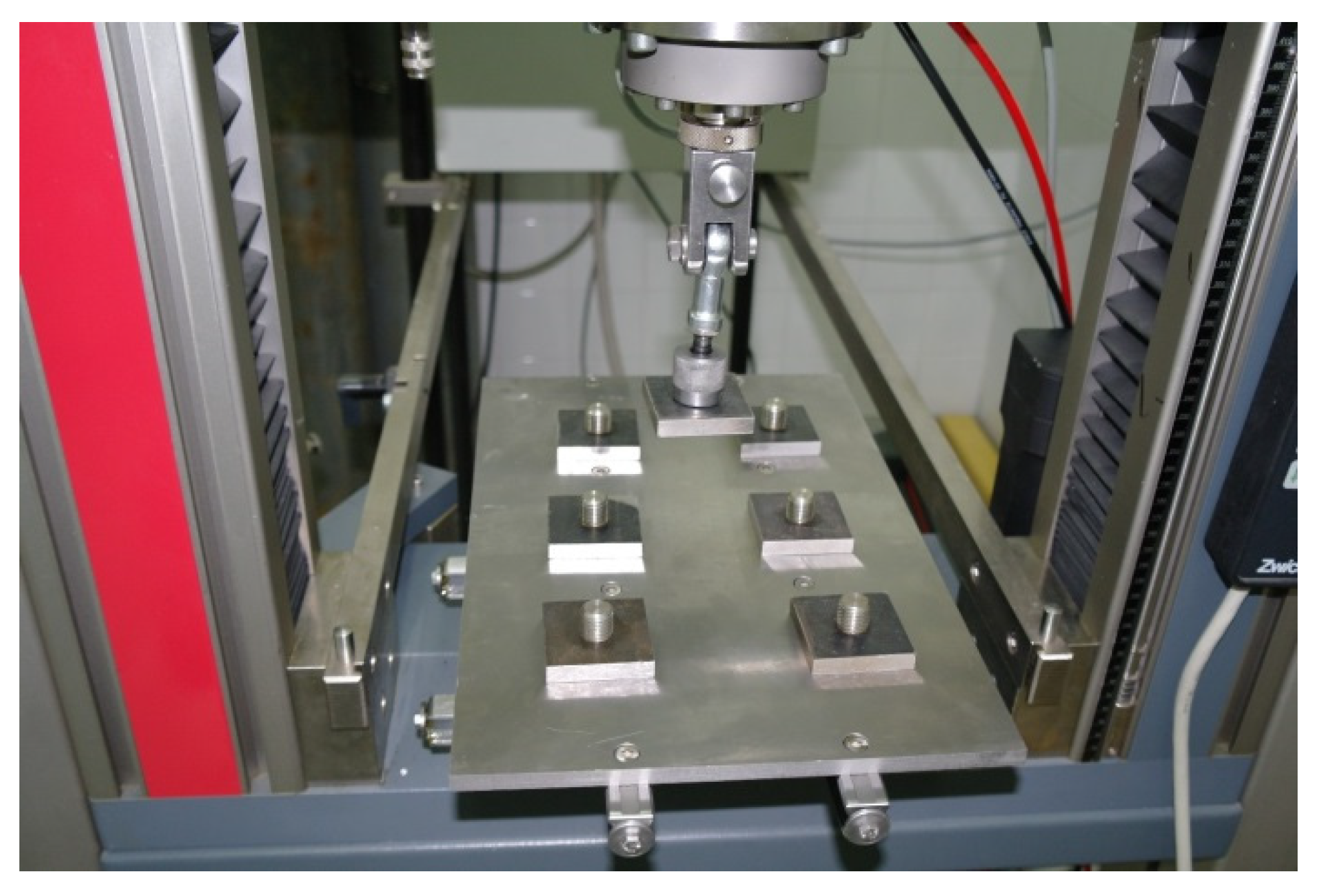
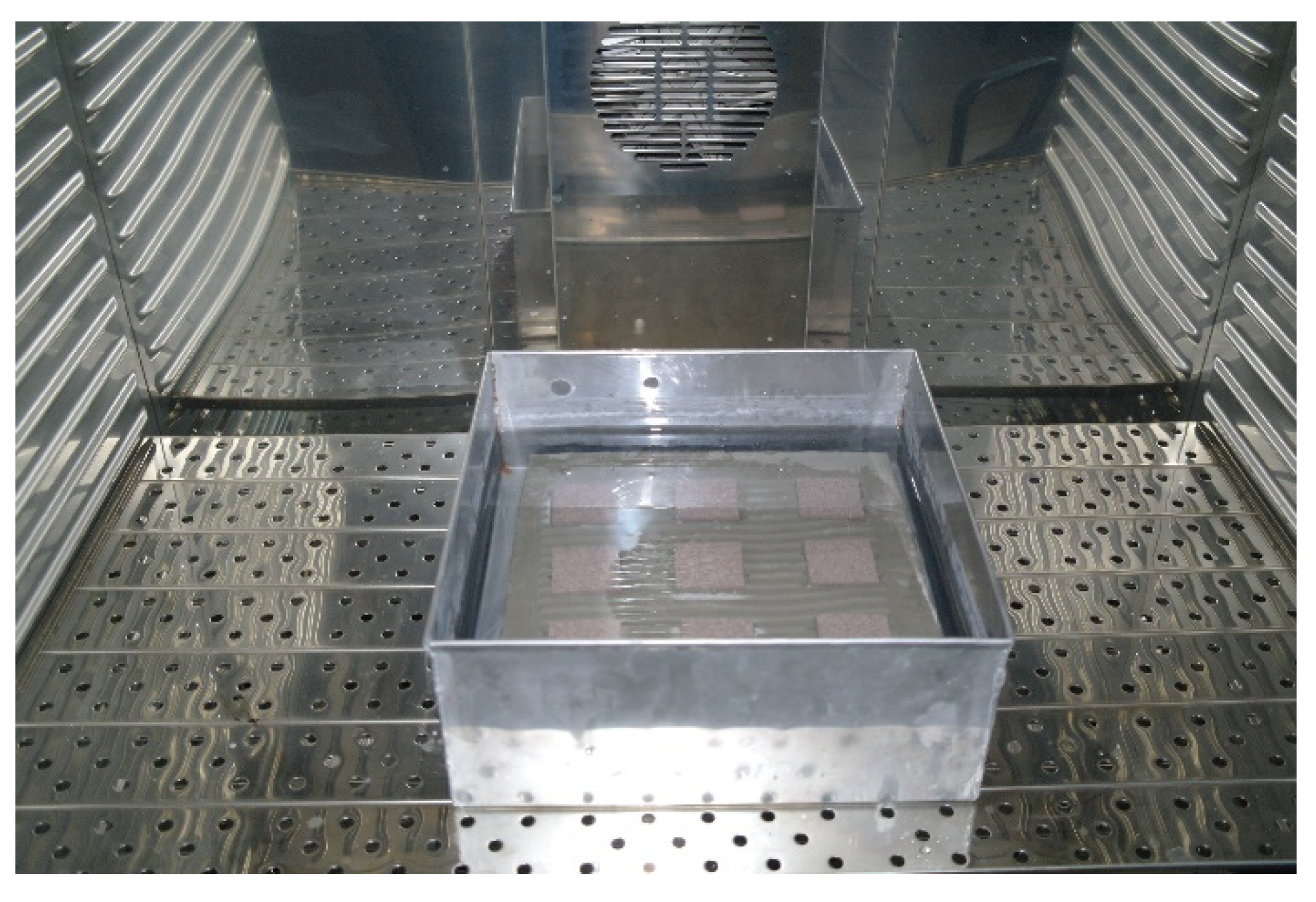
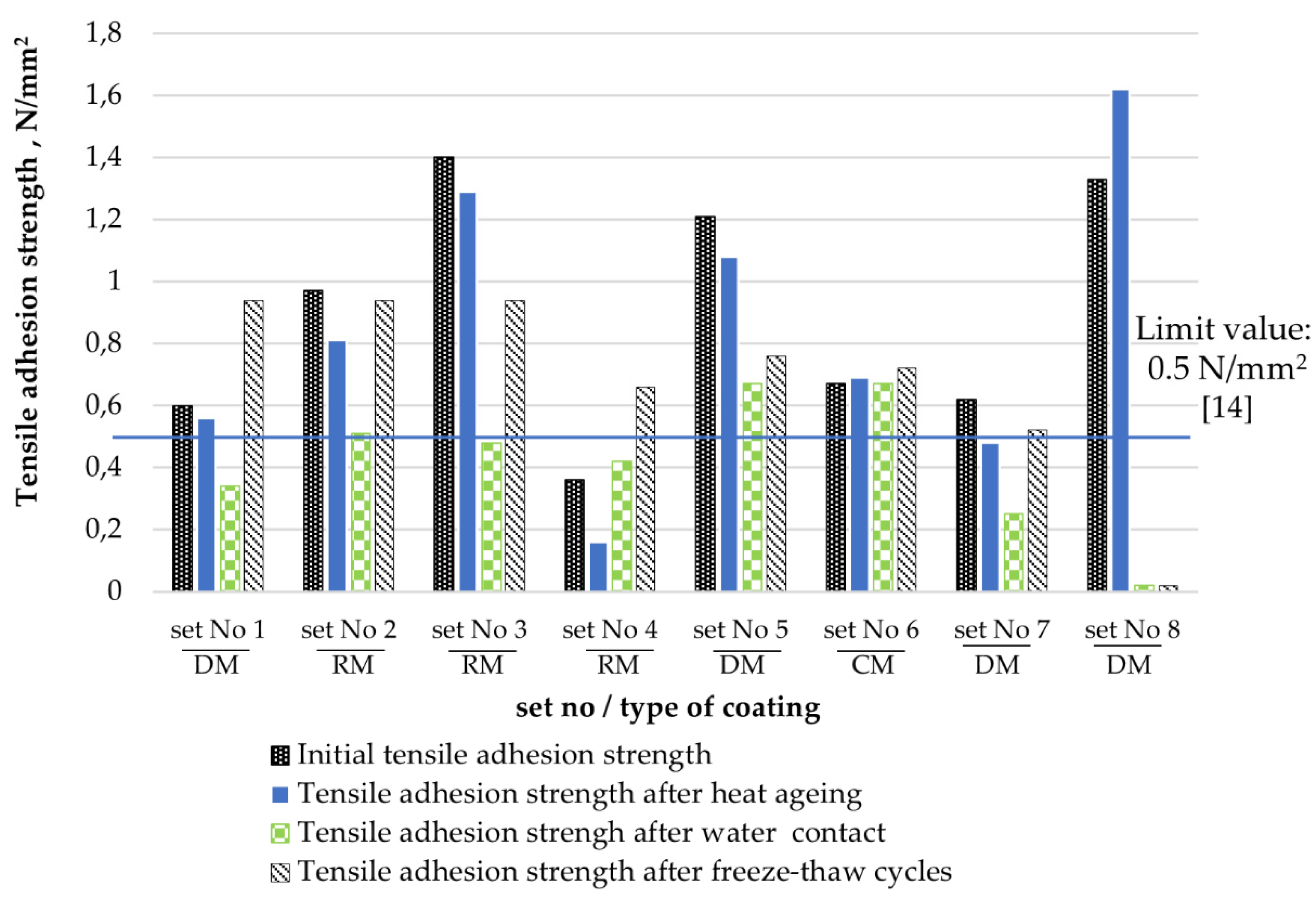

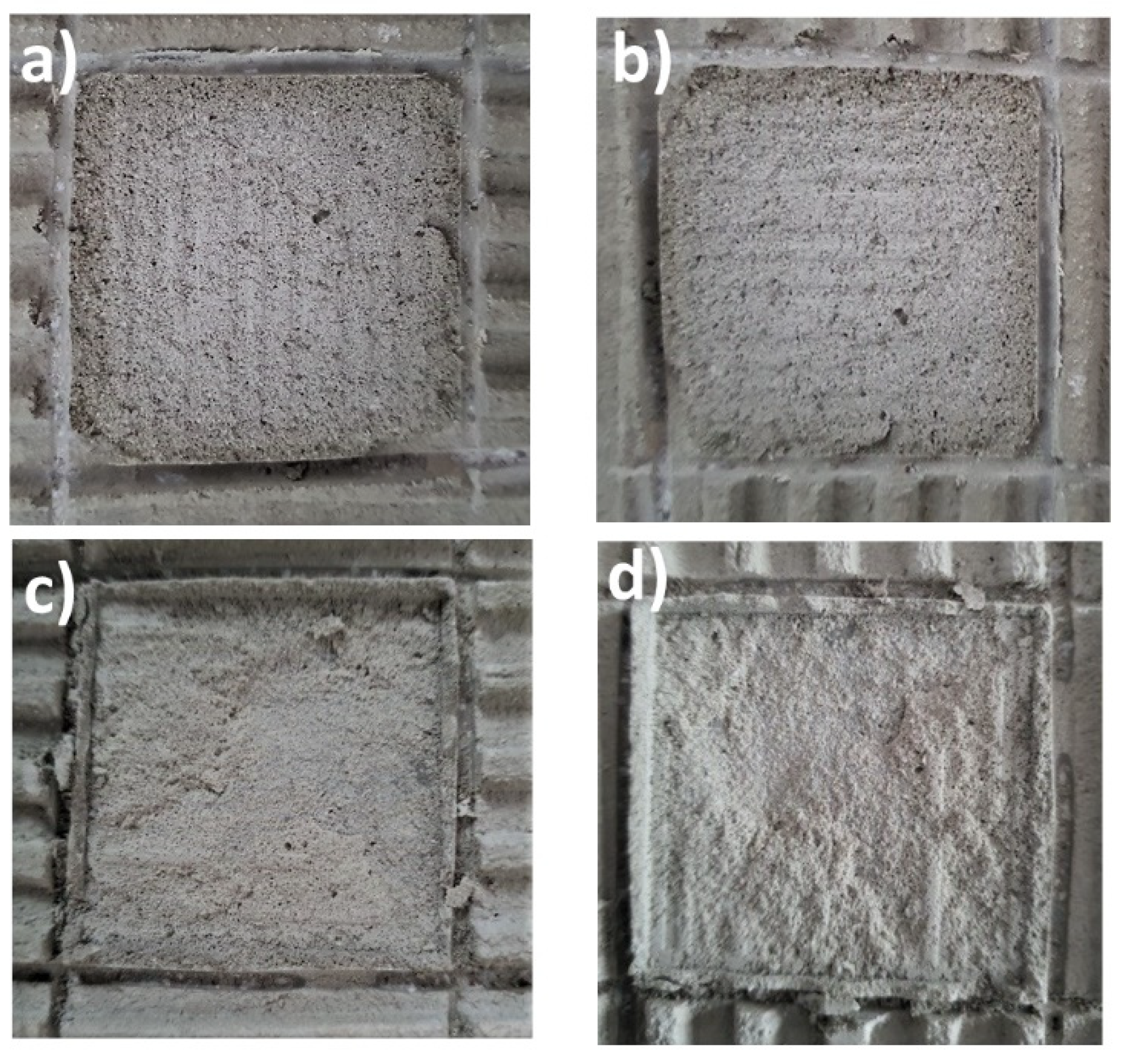

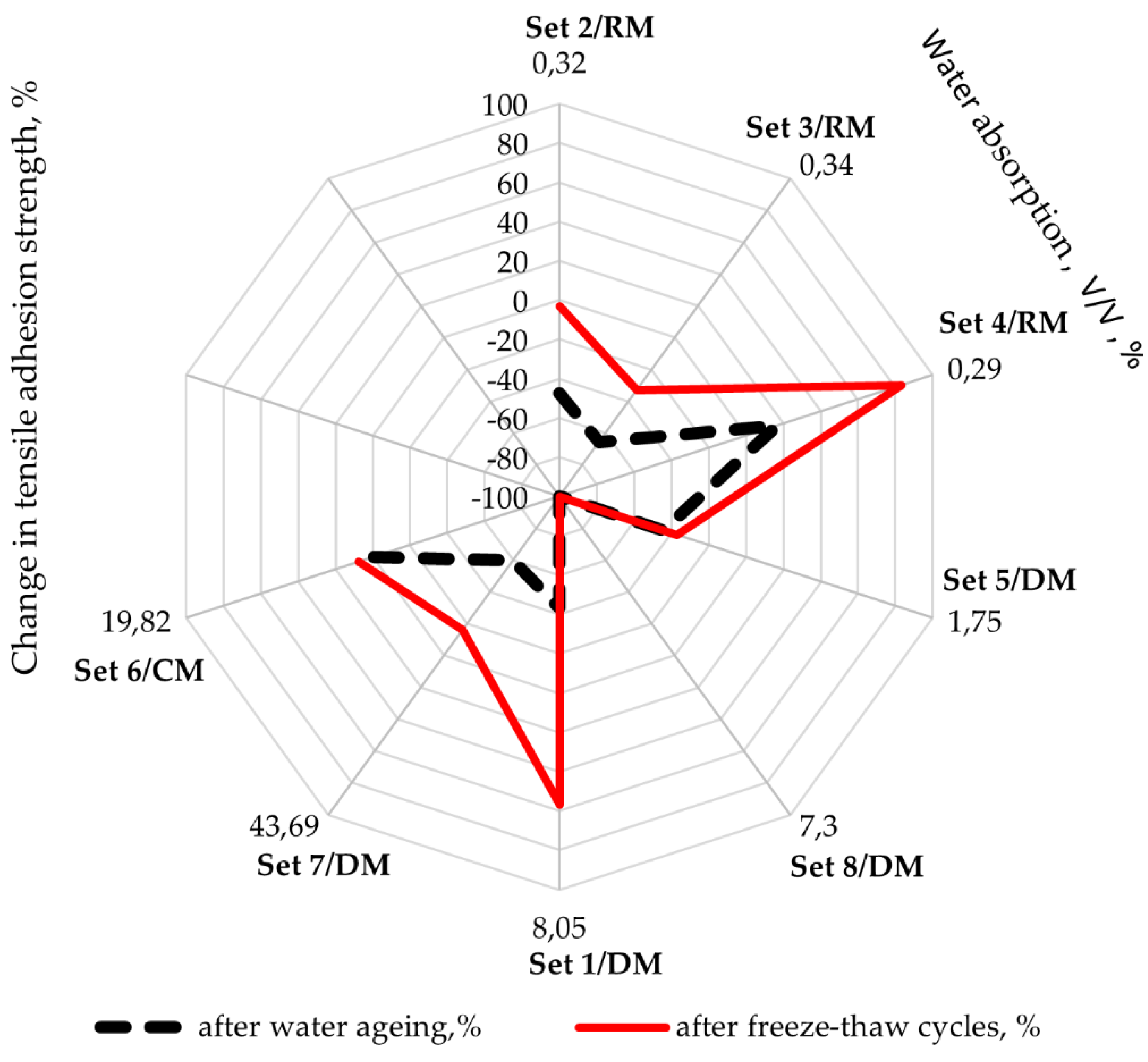
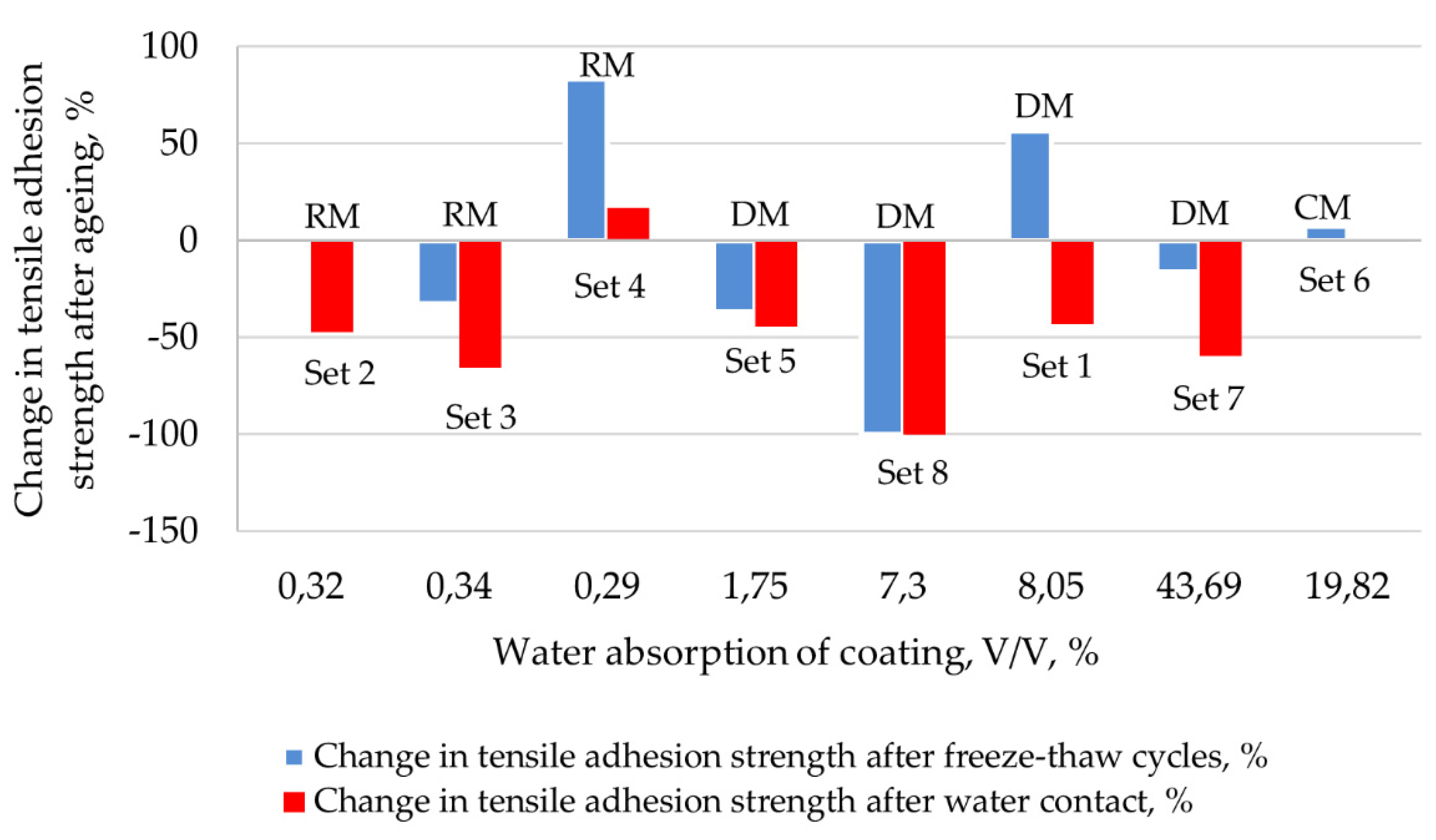
| Test Set Number | Type of Waterproof Coating | Type and Grade of Adhesive Mortar | Watertightness at 150 Kpa for 7 Days | Water Absorption of Coating after 7 Days | |
|---|---|---|---|---|---|
| Weight Increase, G | V/V, %, | ||||
| 1 | DM 1 | C2S1 | No leakage | 6.33 | 8.05 |
| 2 | RM 2 | C2 | No leakage | 0.15 | 0.32 |
| 3 | RM 2 | C2 | No leakage | 0.16 | 0.34 |
| 4 | RM 2 | C2 | No leakage | 0.18 | 0.29 |
| 5 | DM 1 | C2TE | No leakage | 0.55 | 1.75 |
| 6 | CM 3 | C2TE | No leakage | 4.98 | 19.82 |
| 7 | DM 1 | C2TS1 | No leakage | 14.00 | 43.69 |
| 8 | DM 1 | C2TE | No leakage | 1.00 | 7.3 |
| Test Method | Tested Set Number/Symbol of Coating Type/Test Result (Mean Value)—Tensile Adhesion Strength, N/Mm2/Watertightness (Mean Value) | |||||||
|---|---|---|---|---|---|---|---|---|
| 1 | 2 | 3 | 4 | 5 | 6 | 7 | 8 | |
| DM | RM | RM | RM | DM | CM | DM | DM | |
| Initial tensile adhesion strength | 0.60 *) | 0.97 **) | 1.40 **) | 0.36 **) | 1.21 **) | 0.67 *) | 0.62 *) | 1.33 *) |
| Test Method | Tested Set Number/Symbol of Coating Type/Test Result (Mean Value)—Tensile Adhesion Strength, N/Mm2/Watertightness (Mean Value) | |||||||
|---|---|---|---|---|---|---|---|---|
| 1 | 2 | 3 | 4 | 5 | 6 | 7 | 8 | |
| DM | RM | RM | RM | DM | CM | DM | DM | |
| – after heat ageing | 0.56 *) | 0.81 **) | 1.29 **) | 0.16 **) | 1.08 *) | 0.69 *) | 0.48 **) | 1.62 *) |
| Watertightness of the waterproof coating at 150 kPa for seven days—no leakage | ||||||||
| – after water contact | 0.34 **) | 0.51 **) | 0.48 **) | 0.42 **) | 0.67 **) | 0.67 *) | 0.25 **) | 0.0 **) |
| Watertightness of the waterproof coating at 150 kPa for seven days—no leakage | ||||||||
| – after freeze/thaw cycles | 0.94 *) | 0.94 **) | 0.94 **) | 0.66 **) | 0.76 *) | 0.72 *) | 0.52 *) | 0.0 **) |
| Watertightness of the waterproof coating at 150 kPa for seven days—no leakage | ||||||||
| Characteristics | Tested Set No./Type of Coating | |||||||
|---|---|---|---|---|---|---|---|---|
| 1 | 2 | 3 | 4 | 5 | 6 | 7 | 8 | |
| DM | RM | RM | RM | DM | CM | DM | DM | |
| Initial tensile adhesion strength, N/mm2 | 0.60 | 0.97 | 1.40 | 0.36 | 1.21 | 0.67 | 0.62 | 1.33 |
| Tensile adhesion strength change after thermal ageing, % | −6.7 | −16.5 | −7.9 | −55.6 | −10.7 | −3.0 | −22.6 | +21.8 |
| Tensile adhesion strength change after water impact, % | −43.3 | −47.4 | −65.7 | +16.7 | −44.6 | 0.0 | −59.7 | −100.0 |
| Tensile adhesion strength change after freeze/thaw cycles, % | +56.6 | −3.1 | −32.9 | +83.3 | −37.2 | +7.5 | −16.1 | −100.0 |
| Tested Characteristic | Test Set No/Type of Coating/Test Result (Mean Value)—Adhesive Strength N/mm2 | |||||||
|---|---|---|---|---|---|---|---|---|
| 1 | 2 | 3 | 4 | 5 | 6 | 7 | 8 | |
| DM | RM | RM | RM | DM | CM | DM | DM | |
| Water absorption of coating after 7 days, weight increase, g/ V/V, % | 6.33/8.05 | 0.15/0.32 | 0.16/0.34 | 0.18/0.29 | 0.55/1.75 | 4.98/19.82 | 14.0/43.69 | 1.0/7.3 |
| Change in tensile adhesion strength after water contact, % | −43.3 | −47.4 | −65.7 | +16.7 | −44.6 | 0.0 | −59.7 | −100.0 |
| Change in tensile adhesion strength after freeze/thaw cycles, % | +56.6 | −3.1 | −32.9 | +83.3 | −37.2 | +7.5 | −16.1 | −100.0 |
© 2020 by the authors. Licensee MDPI, Basel, Switzerland. This article is an open access article distributed under the terms and conditions of the Creative Commons Attribution (CC BY) license (http://creativecommons.org/licenses/by/4.0/).
Share and Cite
Francke, B.; Piekarczuk, A. Experimental Investigation of Adhesion Failure between Waterproof Coatings and Terrace Tiles under Usage Loads. Buildings 2020, 10, 59. https://doi.org/10.3390/buildings10030059
Francke B, Piekarczuk A. Experimental Investigation of Adhesion Failure between Waterproof Coatings and Terrace Tiles under Usage Loads. Buildings. 2020; 10(3):59. https://doi.org/10.3390/buildings10030059
Chicago/Turabian StyleFrancke, Barbara, and Artur Piekarczuk. 2020. "Experimental Investigation of Adhesion Failure between Waterproof Coatings and Terrace Tiles under Usage Loads" Buildings 10, no. 3: 59. https://doi.org/10.3390/buildings10030059
APA StyleFrancke, B., & Piekarczuk, A. (2020). Experimental Investigation of Adhesion Failure between Waterproof Coatings and Terrace Tiles under Usage Loads. Buildings, 10(3), 59. https://doi.org/10.3390/buildings10030059





